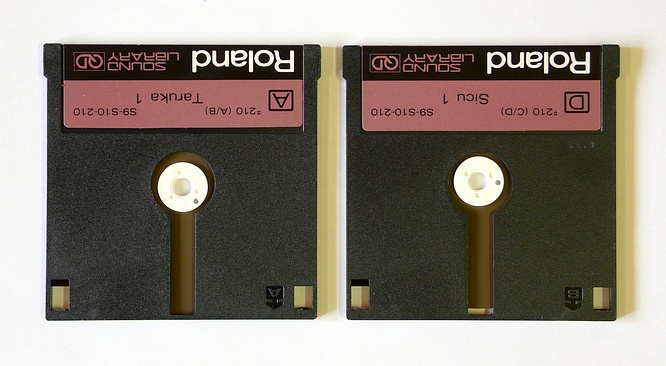

I needed a reliable working drive so I can come up with a way to replace the Quick Disk with a floppy drive emulator board (probably the HxC board).

I owe a large favor to the synth Gods and I fear it's going to be steep if/when the come to collect. The odds were pretty stacked against any sort of revival. I had no idea the drive interface even worked at this point but I was able to get the thing working, saving samples, verifying the saves and reloading them. I just unplugged it and plugged in the Yamaha drive. I wont even touch the drive in this thing it's so horrid. Cleaned that up and put on a suitable elastic band, then dug into the MD-280. I sacrificed a dead MDF-1 I had laying around, pulled the drive out of it and discovered (quelle surprise!) that the drive belt had rotted away to goo. This thing looked like a family of pigeons made a home and shit in it for a decade. I should have left it behind, I should have known better. I just spent the better part of a day reviving an MD-280 that I got for 'free' with my Akai S_612. Thankfully I think there's only a few musical things that have these in them (Akai S-612/MD-280, Akai S-700, Roland S-10, and the bizarre Yamaha MDF-1 MIDI disk drive, anything else?)

*Unreliable, drives and disks can just up and die at any time - CHECK *Drive is notoriously finicky wrt head alignment, motor speed, gearing - CHECK *Drive is belt driven and the belt is made of a material that disintegrates into nasty black goo over time - CHECK *No sliding latch to protect the disk surface from dirt and dust - CHECK *Nonstandard disk size and format - CHECK Take everything that was good about floppy drive technology and throw it out the window. It does not store any personal data.Anyone had the misfortune of using Mitsumi 2.8" Quick Disks? They are quite possibly the biggest technology turd of the 80's (at least for synths). The cookie is set by the GDPR Cookie Consent plugin and is used to store whether or not user has consented to the use of cookies. The cookie is used to store the user consent for the cookies in the category "Performance". This cookie is set by GDPR Cookie Consent plugin.

The cookie is used to store the user consent for the cookies in the category "Other. The cookies is used to store the user consent for the cookies in the category "Necessary". The cookie is set by GDPR cookie consent to record the user consent for the cookies in the category "Functional". The cookie is used to store the user consent for the cookies in the category "Analytics". These cookies ensure basic functionalities and security features of the website, anonymously. Necessary cookies are absolutely essential for the website to function properly. Figuresĭimension (outer casing): 78.1 mm × 75.9 mm × 3 mmĬapacity: 100 KB to 256 KB Sources / Resources A 1991 review refers to the process of using the drive in a Smith Corona word processor as ‘slow (and strangely noisy) and expensive’.įinding a working Quick Disk drive is difficult, and even if you can get one working (you’ll almost certainly need to replace the drive belt), reading data from the disks is likely to be very difficult due to bit rot. The Quick Disk doesn’t appear to been around for long, though it lasted into the early 1990s in the form of the Smith Corona DataDisk and Nintedo Famicom Disk System. Quick Disk drives were also available for some mid-1980s home computers such as the Sinclair ZX Spectrum, the Dragon 32/64, and the Sharp MZ-700 and MZ-800. The Quick Disk was used in some MIDI keyboards, samplers, sequencers and drum machines from manufacturers such as Roland, Korg, Akai and Yamaha. They were also used in some Smith Corona word processors where they were branded as DataDisk (and also sometimes labelled as 2.8-inch disks, referring to the size of the disk inside the casing). The design was used by Nintendo in its Famicom Disk System, with a modified casing that was longer. Drives were single-sided and Quick Disks needed to be turned over to use the other side of the disk In addition, rather than offer random access, data was recorded in a continuous spiral on the disk which took 8 seconds to read (in the 100 KB Triton QD drive) making them slow in use. It was a much simpler design than other floppy disks of the time as it had no shutter mechanism to protect the disk surface from dust and used break-off tabs (rather than a sliding tab) for write-protection. The Quick Disk (QD) was a 3-inch floppy disk design launched by Mitsumi around 1985 (a prototype was shown in 1984).


 0 kommentar(er)
0 kommentar(er)
